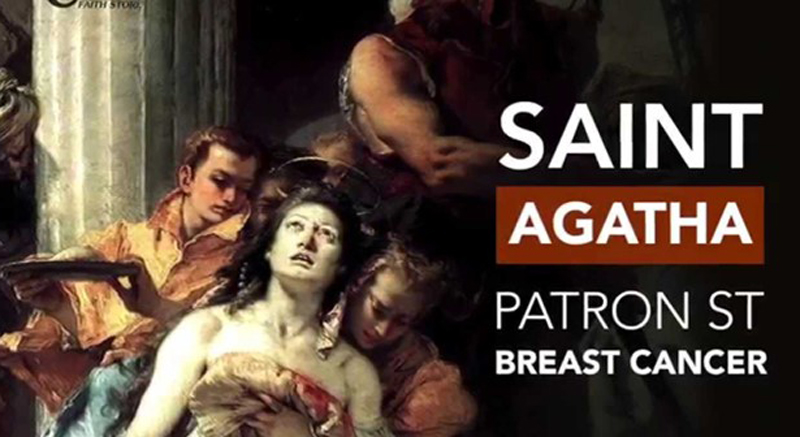(235-251 AD)
Agatha was born to a wealthy noble family at the foot of Mount Etna in Sicily. As an adolescent she committed herself with the ritual of the taking of a red veil signifying the consecrated virgins of those times. Tradition also describes her as a deaconess (an office), dedicated to service in the Christian community.
In 250, AD the edict of Emperor Decius against Christians opened a long persecution, and in Catania, the ruthless proconsul Quintian, who was infatuated with Agatha, was given charge of the edict’s application.
Agatha fled to Palermo, but was found and taken back to Catania, conducted by Quintian. The proconsul demanded that Agatha renounce her faith, but she refused. Determined to attack the virginity of the girl, Quintian entrusted her to a brothel, whose madame Aphrodisia, was to educate the virgin in the arts of love. Agatha remained faithful to Christ, and kept her virginity, so she was sent back to Quintian, who decided to submit her to trial.
The “Acts of the Martyrdom of St. Agatha” report the conversations. “What is your condition?” asked Quintian.
Agatha responded, “Not only was I born free, but of noble family.”
Quintian: “And if you claim to be free and noble, why do you show yourself to live and dress like a slave?”
“Because I am a servant of Christ,” Agatha replied.
Quintian again: “But if you are really free and noble, why do you want to be a slave?”
Agatha: “The greatest freedom and nobility is here: to prove to be Christ’s servants.”
Quintian replied: “And what about it? We who despise the servitude of Christ and venerate the gods have no freedom?”
“Your freedom draws you to such slavery, which not only makes you servants of sin but also submits you to wood and stones,” Agatha said.
In the face of these words Quintian urged Agatha once again to deny Christ, and to induce her to reflect, sent her to jail. The next day, in the face of the young woman’s refusal, he decided to subject her to torture.
Furious to see her face the pain with courage, Quintian commanded that her breasts be torn away. Agatha was brought back to prison sore and bloody, but in the night, St. Peter appeared to her, and healed her wounded breasts. Again, before the court, Agatha again refused to worship the gods and claimed to have been healed by Jesus Christ.
Furious at the girl’s courage despite torture, Quintian decided she was to be raked across hot coals, wrapped only in her red veil, symbol of her betrothal to Christ. When the proconsul’s orders were begun to be carried out the earth shook and the whole city of Catania was shocked by an earthquake. So, they all ran to the judge’s court and he began to tremble greatly because he was tormenting the holy servant of God, and all of them were in grave danger. Agatha, with her veil intact, was taken from the brazier.
Taken to prison, the girl extended her arms to the Lord, and said, “You Lord, who have created and guarded me from my childhood, and made me to act with manly strength, have taken from me the love of the passing world, who kept my body from contamination, who made me overcome the torments of the executioner, the iron, the fire and the chains, who gave me in torment the virtue of patience! Please accept my spirit now, for it is already time that I should leave this world by your command and reach your mercy.”
Speaking these words in the presence of many, she was silent, and gave up her spirit.” It was Feb. 5, 251.
A year after her death, a lava flow from nearby Etna was approaching the city of Catania. The inhabitants prayed for the intercession of Agatha for their safety. Her veil was placed before the lava flow and miraculously the lava stopped. From that day Agatha became the patron of that city and her relics are preserved in the Cathedral of Catania.
Adapted by A. J. Valentini from: St. Agatha, Virgin and Mother – Information on the – Vatican News. (n.d.). Vatican News. Retrieved January 26, 2021, from https://www.vaticannews.va/en/saints/02/05/st–agata–virgin-and-martyr.html
